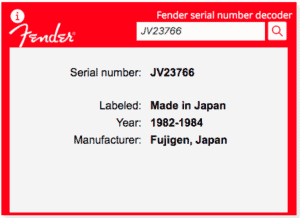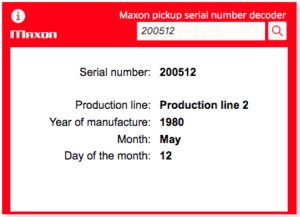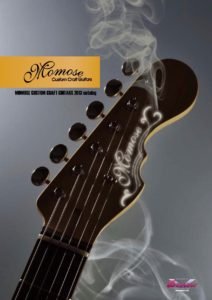Last Updated : December 30, 2023
Greco guitars typically feature Gotoh tailpieces, bridges, and tuners.
As for pickups, Greco initially used Maxon pickups for their instruments in the ’70s and early ’80s, such as the UD, U-1000, and U-2000 models. The acclaimed Dry Z pickup, closely resembling the original PAFs, was developed by Mr. Jun Takano (Music Land Key, later Kandashokai) in collaboration with Mr. Ishimaru (head of the pickups division at Nisshin Onpa) for Maxon. Their collaboration began in the summer of 1979, resulting in three versions before the final production model.
In 1981, Fujigen acquired the entire Pickup Division from Nisshin Onpa (Maxon), including patents, expertise, equipment, and likely the workforce. From 1982 onward, Greco guitars were equipped with pickups manufactured by Fujigen (such as the Dry 82 model).
Early 80’s – Greco Guitars – Super Real Series:
Examples of guitars equipped with pickups manufactured by Nisshin Onpa (Maxon).
Price of the Maxon pickups at the time:
- DRY = 20000 Yen
- PU-2 = 15000 Yen
- U-2000 = 12000 Yen
- U-1000 = 10000 Yen
Corresponding Guitar and Pickup Models:
- EGF1800 = Z DRY
- EGF1200 = Z DRY
- EGF1000 = PAF
- EG1000C = Z DRY
- EG900 = PAF
- EGF850 = PU-2
- EG800GS = HOT LICK
- EG800C = PU-2
- EG800PB = U-2000
- EG800PR = U-2000
- EG800 = PU-2
- EG700 = U-2000
- EG600PB = U-1000
- EG600PR = U-1000
- EG500 = U-1000
- EG500C = UD
- EF500J = U-1000
- EG500GS = UD
- EG480 = UD
- EG450 = UD
1984 – Greco Guitars – Mint Collection Series:
Examples of guitars equipped with pickups manufactured by Fujigen Gakki
Price Fujigen pickups at the time:
- DRY 1982 = 20000 Yen
- DOUBLE TRICK = 18000 Yen
- THE GROOVE = 16000 Yen
- SCREAMIN = 14000 Yen
Corresponding Guitar and Pickup Models:
- EG58-120 = DRY
- EG-59-70 = DOUBLE TRICK
- EG-56-60 = HOT LICK
- EG-59-50 = SCREAMIN
- EG59-45 = SCREAMIN
- EJR54-50 = HOT LICK
- SS63-70 = DOUBLE TRICK
- SS63-50 = HOT LICK
- EG59-65 = SCREAMIN
- JP-55 = SCREAMIN
- EGC95K = DRY
- EGC68-50 = SCREAMIN
- JS-98K = DRY
- JS-65 = DRY
- JS-55 = SCREAMIN
- RR-95K = DRY
- RR-65 = DRY
- RR-55 = SCREAMIN
- EGC58-100 = GROOVE – only first year, after that DRY 1982
- EGC68-80 = DOUBLE TRICK
- EGC57-60 = SCREAMIN
- PC-98K = DRY

Magnets used on Maxon or Fujigen pickups:
- Ferrite : U-1000
- Alnico 3: Dry Z, Dry 1982 (maybe Alnico 2 too).
- Alnico 5: Groove, U-2000, Double Trick, U-4000, PU-0, PU-2
- Alnico 8: U-3000
- Ceramic: U-1000 and UD (starting at the end of 1979), Screamin
The pickups equipped with ceramics used Ferritic 2 and Ferritic 3.2.

You can also utilize our Maxon’s Nisshin Onpa serial decoder.
Greco Pickups made by Maxon (Nisshin Onpa)
Last Updated : December 30, 2023 Greco guitars typically feature...
Read MoreGreco: Super Real collection
In 1980, specifically toward the end of 1979, Greco departed...
Read More








20 Responses
HI.
I am about buying a LP Greco, model: EG-80 (Nensei ???)
Do you know this guitar? and if so, can you tell me all about it 🙂
What is said about it, by seller:” serial 0086 , appeared to Super Real-life EG 700 more advanced stage.
Ebony fretboard; stamp of 210,311 in rear PU ; there is a feeling that has reached the apex of domestic guitar that era. ”
Well, can you light my lantern? Great thanks ! Waiting for your answer. ( I forgot to tell about the price: bid starts at 621 USD ) Best regards. Kjeld Dalsbaek
Hello Kjeld, some things are probably wrong here. Serial number can’t be 4 digits only and EG-80 doesn’t exist. So maybe an EG-800 with serial number like 1 0086? Have you checked the Greco catalogs that are available on this website for more details about the model your are looking at?
I recently purchased an SG style guitar but it does not say Greco on the head stock but the serial number looks just like a Greco serial number from the mid 70’s. It has a Crown logo on the headstock but not GRECO The serial on the four bolt neck plate is G762495. July 1976. My wonder is about the pickups? Could they be the PAF models. They sound like a humbucker from 1957.
Were the PAF styled Maxon pickups not made that early? I wish I had a way of sending you some pictures. If you like you can respond to rw*****@sw****.net thanks, Richard Parks Fort Worth, Tx. July 7, 2019.
Hello Richard, you have to check the base plate of your pickups to see if there is something like brand and/or serial. If your 70’s guitar is indeed Made in Japan, the pickups are more likely Maxon since they worked with many brands.
Hi!
I have a Greco SA550 with no serial number. I just find a number in the pickup, but it don’t match mith your pickup codes: 25523.
Anybody can help me to date my guitar?
Thanks!
1975
Argg!!! sorry… my serial number match mith the first example! So my guitar was manufactured in 1975/05/23.
Thanks!
Hi, I have a Greco 335 copy, no serial number but, has an F3276 inked inside on body under F-hole, 2 screws for neck hold plate, pickups are Maxon 13810 stamped on neck pup and 3810 on bridge pup. No inlay on headstock under the Greco logo sticker. I can’t find any guitar like this on the net. It almost looks like it’s 2 different guitars. It all matches, color, binding neck etc…. can’t find the Maxon pups anywhere either and they don’t look like others on the bottom, there are 4 slots on the plate, 3 pup screws in 2 of the slots and other two are closed with some sort of wax paper covering them. Any help would be appreciated identifying the year or model. Has the tail piece that is long with the diamond on the string plate. Not the les paul type where the strings wrapped around the bridge.
Letters, i.e, A,B,C,D,E,F,G denote the months of manufacture. A being Jan., B being Feb. Hope this helps too!
I’m assuming that you are referring to the Greco guitars serial number and not Maxon pickups serial.
I just bought a 1978 greco eg- 1000 suppodely, which i think is most probably a eg -600 c , its is chambered , pancaked and, the neck pickup i checked out had no stamp and just an M written on it. Have you seen anything like that before? Is this a legit Maxon pickup ?
Hello JIMM, you’re right.
EG-1000 model is not chambered nor pancake, so your guitar can be an EG-600.
The pickup is not original.
Hi Frankie,
I’m looking at a EG700 SN#B787126. All the solder joints appear to be original along with the pickups but the pickups don’t have any numbers on them. Did Maxon ever produce pickups without numbers? I can send you pictures if that helps. Thanks!
Hello,
No, a 1978 EG700 should have U2000 pickups with 5 digits SN.
Hi friend, I bought a Greco Les Paul, but dont know exactly what model is. The colour is a Tobacco Sunburst, the logo is the early GNECO style, 3 point Truss Rod Cover, i think rosewood fingerboard, and have a little star mark in the wood, at the end of the 22nd fret. Have a set neck, chambered body, 6 point backplate for electronics, and the weird thing is that have a serial in the headstock, but seems to be fake, B786488, but the pickup is a Maxon with Serial 34329. With this specs, doesnt fit with the models i found in this website. What i know is that is heavily modified. My apologies for write a testament, do you know by the description what model is exactly or it is a fake greco?
Best regards.
Hello Frankie, I’m on this page after recently discovering something terrible happened with my 1980 EG1000CB. Bought it off craigslist in NYC around 2013. It is my favorite guitar. When I first got it, I confirmed it had the Z on the pickups. They looked cleaner than most I saw online and both had the exact same numbers. Other than the Z, I remember they started with 200. It looked like they were put in the guitar with love. I have images of the pickups on a hard drive from before my first iphone but this is stored with family in Wisconsin.
A few weeks ago, I decided to give the guitar a good cleaning while changing strings. For the first time in at least 7 years, I removed one of the pickups. Before I turned it over, I had a sudden terrible feeling. And it was real. The Z was now gone! Both the pickups now start with 210!! One thing I know is both my pickup covers are the same, because of wear markings. I could see the solder had been disturbed a bit but could tell how fresh. But it was clear someone stole my original Dry Z pickups and tried to make these ones look like the originals! What made it worse was that I discovered this only a week after my catalytic converter was sawn off from under my Prius.
The only time this theft could have happened was at repair shops during setups. No one else has had access. What a nightmare. Maybe four years back, I changed from round to flatwound and back to roundwound strings. I have used 5-6 different different repair shops over the decade. But these have all been small, highly rated places. Never have I felt any distrust of any of the shops or repair techs. All I can imagine is someone at the shop saw this guitar on the rack while waiting for a setup and thieved it in the night. I now feel like such an idiot for trusting these places enough to not check every so often.
I’ve cooled down somewhat in the last couple weeks, but I am still furious. When I play my guitar now I can’t help but feel like I noticed it’s had a brighter, louder tone in the last few years. This was likely part of why I tried flatwounds. Thing is, it really sounds and feels the same as I alway remember, for the most part. Last week, I tested the magnets on these pickups. They don’t pass current so I assume they are ceramic. From what I can tell, they’re UD pickups from a 80-81 EG500 or similar. The number font looks very close to my originals but much more smudged.
Other than the magnets, are the UD pickups really close to the Dry Z? How different is the winding material, quality, and amount of winds? Would I end up with a tone close to the original by swapping out the ceramic magnet for Alnico 3s?
Hello Matt,
It’s a very sad story. Dry Z’s easily sell for over $1000 today.
If you have the full serial number on an old photo, you could search through the listing archives of major sites like craigslist, reverb, e-bay, and others to find who sold them.
Regards.
Thank you Frankie. I will do a search once I have the old photos. Moving forward, I am curious about the pickups that are currently in my guitar. They are marked 210130 and 210327. Definitely seem of the same era and production line. Would swapping the ceramic magnets for alnico 3s be a worthwhile experiment? Of course i know these pickups will never be Dry Zs. Though I truly wonder how many years I was blissfully playing my guitar without knowing about the pickup change. My Greco has always sounded better than all my other humbucker guitars.
While scouring through images for my missing Zs I believe I read someone with contact to Maxon say the only difference between the 1980-81 pickups was the magnets. That the windings were the same until the Dry 82. Curious if this is true.
The funny is while searching for this comment today, I just found someone’s old post on mylespaul asking a question about pickups in his black 1981 EGC500. This was in 2019. He is specifically asking if the pickups in his guitar might be Dry Zs. They are not but guess what… one of the photos looks “almost” exactly like one of my pickups. I say this because much of the soldering residue looks identical. The id numbers look identical down to the fading. Yet I look again and some of the surface looks a tad different. Want to be certain before I move forward contacting this person or posting more details.
The guitar that was being sold on this old listing looks like the twin sister of my guitar.
–reverb.com/item/17380783-greco-eg-1000c-dry-z-super-real-custom-black-beauty-1980-located-in-us–
My Greco is pretty beat up though. Most of the gold is worn from the hardware. There’s a good number of chips and it’s got more than a few scratches. It plays perfectly though. I remember the back of the pickups looking just like these ones, but both numbers were even more clearly readable.
Curious if anyone has insight on whether it’s true that the early lineup of Maxon 1980 Super Real pickups are basically identical aside from the magnets.